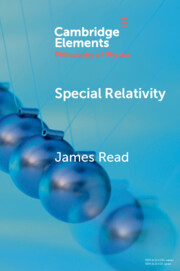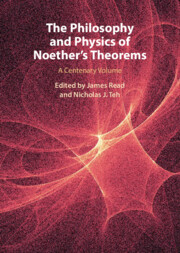97 results

Special Relativity
-
- Published online:
- 26 June 2023
- Print publication:
- 20 July 2023
-
- Element
- Export citation
A new snow leopard record reflects the value of remote protected areas for connectivity
-
- Article
-
- You have access
- Open access
- HTML
- Export citation
Severe acute respiratory coronavirus virus 2 (SARS-CoV-2) outbreaks in nursing homes involving residents who had completed a primary coronavirus disease 2019 (COVID-19) vaccine series—13 US jurisdictions, July–November 2021
-
- Journal:
- Infection Control & Hospital Epidemiology / Volume 44 / Issue 6 / June 2023
- Published online by Cambridge University Press:
- 16 January 2023, pp. 1005-1009
- Print publication:
- June 2023
-
- Article
- Export citation
A social practice theory approach to exploring the ubiquity of quizzes in dementia care settings
-
- Journal:
- Ageing & Society , First View
- Published online by Cambridge University Press:
- 21 October 2022, pp. 1-22
-
- Article
-
- You have access
- Open access
- HTML
- Export citation
Introduction
-
-
- Book:
- The Philosophy and Physics of Noether's Theorems
- Published online:
- 22 September 2022
- Print publication:
- 29 September 2022, pp 1-3
-
- Chapter
- Export citation
Index
-
- Book:
- The Philosophy and Physics of Noether's Theorems
- Published online:
- 22 September 2022
- Print publication:
- 29 September 2022, pp 377-378
-
- Chapter
- Export citation
Frontmatter
-
- Book:
- The Philosophy and Physics of Noether's Theorems
- Published online:
- 22 September 2022
- Print publication:
- 29 September 2022, pp i-iv
-
- Chapter
- Export citation
Contributors
-
- Book:
- The Philosophy and Physics of Noether's Theorems
- Published online:
- 22 September 2022
- Print publication:
- 29 September 2022, pp vii-viii
-
- Chapter
- Export citation
10 - Geometric Objects and Perspectivalism
-
-
- Book:
- The Philosophy and Physics of Noether's Theorems
- Published online:
- 22 September 2022
- Print publication:
- 29 September 2022, pp 257-273
-
- Chapter
- Export citation
Contents
-
- Book:
- The Philosophy and Physics of Noether's Theorems
- Published online:
- 22 September 2022
- Print publication:
- 29 September 2022, pp v-vi
-
- Chapter
- Export citation

The Philosophy and Physics of Noether's Theorems
- A Centenary Volume
-
- Published online:
- 22 September 2022
- Print publication:
- 29 September 2022
7 - It’s just not cricket: rules and the gentleman’s game
-
-
- Book:
- Advances in Sports Economics
- Published by:
- Agenda Publishing
- Published online:
- 20 December 2023
- Print publication:
- 09 December 2021, pp 85-108
-
- Chapter
- Export citation
Antidepressant withdrawal – the tide is finally turning
- Part of
-
- Journal:
- Epidemiology and Psychiatric Sciences / Volume 29 / 2020
- Published online by Cambridge University Press:
- 22 August 2019, e52
-
- Article
-
- You have access
- Open access
- HTML
- Export citation
5 - Exoplanets and the Sun
-
-
- Book:
- Zonal Jets
- Published online:
- 26 February 2019
- Print publication:
- 28 February 2019, pp 104-116
-
- Chapter
- Export citation
Correlative Spectromicroscopy Software Development on the SGM and Mid-IR Beamlines at the CLS
-
- Journal:
- Microscopy and Microanalysis / Volume 24 / Issue S2 / August 2018
- Published online by Cambridge University Press:
- 10 August 2018, pp. 494-495
- Print publication:
- August 2018
-
- Article
-
- You have access
- Export citation
9 - The Global Circulation
-
-
- Book:
- The Atmosphere and Climate of Mars
- Published online:
- 05 July 2017
- Print publication:
- 29 June 2017, pp 229-294
-
- Chapter
- Export citation
Political Creativity: Reconfiguring Institutional Order and Change. Edited by Gerald Berk, Dennis C. Galvan, and Victoria Hattam. Philadelphia: University of Pennsylvania Press, 2013. 374p. $69.95.
-
- Journal:
- Perspectives on Politics / Volume 14 / Issue 1 / March 2016
- Published online by Cambridge University Press:
- 21 March 2016, pp. 211-212
- Print publication:
- March 2016
-
- Article
- Export citation
Contributors
-
-
- Book:
- The Cambridge Dictionary of Philosophy
- Published online:
- 05 August 2015
- Print publication:
- 27 April 2015, pp ix-xxx
-
- Chapter
- Export citation
Contributors
-
-
- Book:
- Settlement, Society and Cognition in Human Evolution
- Published online:
- 05 February 2015
- Print publication:
- 26 January 2015, pp xiii-xvi
-
- Chapter
- Export citation

